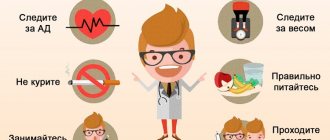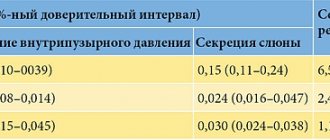Instructions Cardiomagnyl
The drug should be used after a doctor's prescription.
ASA can provoke bronchospasm, as well as cause attacks of bronchial asthma and other hypersensitivity reactions. Risk factors include a history of bronchial asthma, hay fever, nasal polyposis, chronic respiratory diseases, and allergic reactions to other drugs (for example, skin reactions, itching, urticaria).
ASA can cause bleeding of varying severity during and after surgery. Several days before planned surgery, the risk of bleeding should be assessed in comparison with the risk of ischemic complications in patients taking low doses of ASA. If the risk of bleeding is significant, ASA should be temporarily discontinued.
The combination of ASA with anticoagulants, thrombolytics and antiplatelet drugs is accompanied by an increased risk of bleeding.
ASA in low doses can trigger the development of gout in predisposed patients (those with reduced excretion of uric acid).
The combination of ASA with methotrexate is accompanied by an increased incidence of side effects from the hematopoietic organs.
High doses of ASA have a hypoglycemic effect, which must be kept in mind when prescribing it to patients with diabetes mellitus receiving oral hypoglycemic agents and insulin.
When using systemic glucocorticosteroids (GCS) and salicylates in combination, it should be remembered that during treatment the concentration of salicylates in the blood is reduced, and after discontinuation of systemic glucocorticosteroids (GCS), an overdose of salicylates is possible.
The combination of ASA with ibuprofen is not recommended in patients with an increased risk of cardiovascular diseases: when used simultaneously with ibuprofen, there is a decrease in the antiplatelet effect of ASA in doses up to 300 mg, which leads to a decrease in the cardioprotective effects of ASA.
Exceeding the dose of ASA above the recommended therapeutic doses is associated with the risk of gastrointestinal bleeding.
With long-term use of low doses of ASA as aggregative therapy, caution must be exercised in elderly patients due to the risk of gastrointestinal bleeding.
When taking ASA simultaneously with alcohol, there is an increased risk of damage to the mucous membrane of the gastrointestinal tract and prolongation of bleeding time.
Cardiomagnyl®
The drug should be used after a doctor's prescription.
ASA can provoke bronchospasm, as well as cause attacks of bronchial asthma and other hypersensitivity reactions. Risk factors include a history of bronchial asthma, hay fever, nasal polyposis, chronic respiratory diseases, and allergic reactions to other drugs (for example, skin reactions, itching, urticaria).
ASA can cause bleeding of varying severity during and after surgery. Several days before planned surgery, the risk of bleeding should be assessed in comparison with the risk of ischemic complications in patients taking low doses of ASA. If the risk of bleeding is significant, ASA should be temporarily discontinued.
The combination of ASA with anticoagulants, thrombolytics and antiplatelet drugs is accompanied by an increased risk of bleeding.
ASA in low doses can trigger the development of gout in predisposed patients (those with reduced excretion of uric acid).
The combination of ASA with methotrexate is accompanied by an increased incidence of side effects from the hematopoietic organs.
High doses of ASA have a hypoglycemic effect, which must be kept in mind when prescribing it to patients with diabetes mellitus receiving oral hypoglycemic agents and insulin.
When using systemic glucocorticosteroids (GCS) and salicylates in combination, it should be remembered that during treatment the concentration of salicylates in the blood is reduced, and after discontinuation of systemic glucocorticosteroids (GCS), an overdose of salicylates is possible.
The combination of ASA with ibuprofen is not recommended in patients with an increased risk of cardiovascular diseases: when used simultaneously with ibuprofen, there is a decrease in the antiplatelet effect of ASA in doses up to 300 mg, which leads to a decrease in the cardioprotective effects of ASA.
Exceeding the dose of ASA above the recommended therapeutic doses is associated with the risk of gastrointestinal bleeding. With long-term use of low doses of ASA as aggregative therapy, caution must be exercised in elderly patients due to the risk of gastrointestinal bleeding. When taking ASA simultaneously with alcohol, there is an increased risk of damage to the mucous membrane of the gastrointestinal tract and prolongation of bleeding time.
To avoid stomach problems, it is better to take Cardiomagnyl immediately after breakfast.
Traditionally, autumn is the time when all chronic diseases worsen. The gastrointestinal tract is especially sensitive to seasonal changes. Temperature, weather conditions, light conditions change... All this greatly affects a person’s hormonal background and his digestive system. It is not surprising that during the “direct line” with Candidate of Medical Sciences, Associate Professor of the Department of Emergency Surgery of the BelMAPO, curator of the city Center for Gastroduodenal Bleeding at the 10th Clinical Hospital of Minsk Sergei SHOROH, questions from readers of “SB. Belarus today” rained down non-stop.
Get to know yourself better
Maria Budnik: Hello! I have been living with an unpleasant problem for a long time, most likely associated with some kind of gastrointestinal disease. I constantly feel a salty taste in my mouth. Sometimes it is accompanied by a burning sensation. And I’ve been coughing for many years without a cold. What can cause such manifestations? Please advise what should I do about this?
- Most likely, your stomach acidity is impaired. It is also possible that this is a violation of the reflux of acid from the stomach into the esophagus, when it does not close completely. In order not to guess now, you need to conduct examinations. First check the acidity level. And to exclude more serious diagnoses, do an endoscopy of the stomach and duodenum. The fact is that there are pathologies that are not visible on x-rays, but you can see them with your eyes.
Cardiomagnyl tablet s/p/v 75 mg+15.2 mg 30 pcs
The drug should be used after a doctor's prescription. ASA can provoke bronchospasm, as well as cause attacks of bronchial asthma and other hypersensitivity reactions. Risk factors include a history of bronchial asthma, hay fever, nasal polyposis, chronic respiratory diseases, and allergic reactions to other drugs (for example, skin reactions, itching, urticaria).
ASA can cause bleeding of varying severity during and after surgery. Several days before planned surgery, the risk of bleeding should be assessed in comparison with the risk of ischemic complications in patients taking low doses of ASA. If the risk of bleeding is significant, ASA should be temporarily discontinued. The combination of ASA with anticoagulants, thrombolytics and antiplatelet drugs is accompanied by an increased risk of bleeding.
ASA in low doses can trigger the development of gout in predisposed patients (those with reduced excretion of uric acid).
The combination of ASA with methotrexate is accompanied by an increased incidence of side effects from the hematopoietic organs.
High doses of ASA have a hypoglycemic effect, which must be kept in mind when prescribing it to patients with diabetes mellitus receiving oral hypoglycemic agents and insulin.
When using systemic glucocorticosteroids (GCS) and salicylates in combination, it should be remembered that during treatment the concentration of salicylates in the blood is reduced, and after discontinuation of systemic glucocorticosteroids (GCS), an overdose of salicylates is possible.
The combination of ASA with ibuprofen is not recommended in patients with an increased risk of cardiovascular diseases: when used simultaneously with ibuprofen, there is a decrease in the antiplatelet effect of ASA in doses up to 300 mg, which leads to a decrease in the cardioprotective effects of ASA.
Exceeding the dose of ASA above the recommended therapeutic doses is associated with the risk of gastrointestinal bleeding.
With long-term use of low doses of ASA as aggregative therapy, caution must be exercised in elderly patients due to the risk of gastrointestinal bleeding.
When taking ASA simultaneously with alcohol, there is an increased risk of damage to the mucous membrane of the gastrointestinal tract and prolongation of bleeding time.
Effect on the ability to drive vehicles and moving machinery During treatment with ASA drugs, care must be taken when driving vehicles and engaging in potentially hazardous activities that require increased concentration and speed of psychomotor reactions.
What should you not do while taking Cardiomagnyl?
Be sure to consult your family doctor before taking other medications containing acetylsalicylic acid. Also avoid other NSAID drugs. The combined use of such drugs can lead to an overdose. Contact your doctor and carefully read the instructions for the medicine.
Note! It is strictly forbidden to drink alcohol while taking this drug. Concomitant use may cause gastric bleeding.
Method of administration and dosage of Cardiomagnyl
The dosage of Cardiomagnyl depends on your indications and individual characteristics of the body. Only your attending physician, after a thorough medical history, can determine the dose of the drug you need.
Below are the recommended dosages of Cardiomagnyl according to the State Register of Medicines of Ukraine.
Recommended dosages according to the State Register of Medicines of Ukraine
| Diagnosis | Dosage |
| Acute and chronic ischemic heart disease | initial dose - 150 mg per day; maintenance dose - 75 mg per day |
| Primary prevention of thrombosis, cardiovascular diseases | prophylactic dose - 75 mg per day |
| Acute myocardial infarction, unstable angina | 150-450 mg immediately after symptoms appear |
| Prevention of recurrent thrombosis | initial dose - 150 mg per day; maintenance dose - 75 mg per day |
Note! Patients with impaired liver and kidney function require dose adjustment.
Possibility of using Cardiomagnyl in patients with diabetes mellitus
IN
In recent years, the number of patients with type 2 diabetes mellitus (DM) has increased in the world, and by 2021 a further increase in the prevalence of this disease is predicted. Diabetes is associated with an increased risk of myocardial infarction, stroke, and cardiovascular mortality. Therefore, effective treatment of diabetes is one of the main problems of both endocrinology and cardiology.
As is known, diabetes is accompanied by platelet hyperactivity, significantly increased serum levels of thromboxane A2, accelerated platelet turnover, more rapid development of atherosclerosis and an increased incidence of thromboembolism. This suggests that diabetic patients with coronary artery disease might primarily benefit from acetylsalicylic acid (ASA).
This hypothesis was studied in the Physicians' Health Study
(1989): 10.1% of patients with diabetes who took part in this study and received placebo had myocardial infarction;
whereas among those receiving ASA, myocardial infarction developed only in 4% of cases. Moreover, in patients with diabetes, the benefit from taking ASA in terms of preventing myocardial infarction was greater (relative risk 0.39) than in patients without diabetes (relative risk 0.6). Similar results were obtained in another study, which involved 2368 patients with non-insulin-dependent diabetes and coronary disorders (group 1) and 8586 patients with coronary disorders without diabetes (group 2). At the end of the follow-up period, which averaged 1.5 years, patients with diabetes received significantly more benefit from taking ASA. In group 1, for example, taking ASA prevented 5 deaths from cardiovascular causes for every 1000 patients treated, while in the second group this figure was only 2.1. Overall, the mortality rate in the first group was 10.9%, compared with 15.9% in the second group. Moreover, the overall mortality rates in the group with diabetes were lower (18.4%) than in the group of patients without diabetes (26.2%). ASA prevented death in 7.8 out of 1000 patients with diabetes and coronary problems and in 4.1 out of 1000 patients without diabetes with coronary artery disease (Table 1). Both studies mentioned above have been questioned by some researchers who did not find a similar effect or found less pronounced effects. Thus, the results of a meta-analysis of the Antithrombotic Trialists' Collaboration
(2002), summing up the results of treatment of 4961 patients with diabetes in 9 randomized trials, revealed that the use of ASA led to a reduction in the risk of serious cardiovascular complications (non-fatal myocardial infarction + non-fatal stroke + death from cardiovascular causes) by only 7%.
The American Diabetes Association (ADA) (1999) for secondary prevention of large vessel disease in diabetic patients recommends taking ASA in a dose of 81 to 325 mg per day. Moreover, the ADA recommends ASA as a drug for primary prevention in patients with classic risk factors, such as a family history of coronary artery disease, smoking, high blood pressure, excess body weight (> 120% of ideal body weight, body mass index > 28 in women and > 27.3 in men), abnormal blood lipid levels (cholesterol > 200 mg%; LDL cholesterol > 130 mg%; HDL cholesterol < 40 mg%; triglycerides > 250 mg%). Since there is not yet sufficient experience with the use of ASA in young people with diabetes, the ADA recommendations apply only to patients over 30 years of age.
In addition, the administration of ASA to patients with diabetes helps prevent complications of diabetes itself. Thus, long-term observations (14 years) showed that regular use of ASA protects diabetic patients from lower limb amputations. The risk of amputation among patients who develop diabetes before age 30 is reduced by approximately 20%. One pilot study showed that in patients with type 1 diabetes, ASA may influence microalbuminuria (Gue et al., 1998). ASA is probably not contraindicated in diabetic retinopathy because it does not increase the incidence of vitreous hemorrhage and does not adversely affect the course of the disease ( EDTRS
1992).
Moreover, ASA therapy (either monotherapy or in combination with dipyridamole) results in significantly fewer retinal microaneurysms than placebo ( DAMAD
Study Group, 1989).
Despite the obvious benefits of using ASA in diabetes, its use in clinical practice is limited due to side effects. In addition to the risk of bleeding, which is increased in elderly patients, while taking corticosteroids, as well as in the presence of a history of peptic ulcer disease, the main clinical problem of prescribing ASA is the frequent side effects from the gastrointestinal tract (increased incidence of erosive and ulcerative lesions of the gastrointestinal tract and dyspeptic symptoms).
The occurrence of erosive and ulcerative lesions of the stomach while taking ASA, even in doses used in cardiology, is a well-known fact. These ulcers can be effectively treated with the same medications used for peptic ulcers. As a rule, scarring of the ulcer occurs faster if ASA is canceled, under this condition the timing of scarring is similar to the timing of scarring for peptic ulcer disease - at 4–8 weeks of treatment. However, if ASA therapy is continued, despite the identified erosive and ulcerative lesions of the gastrointestinal tract, the scarring rates are quite satisfactory: by the 4th week of treatment, 60–75% of ulcers are scarred.
For a long time, many considered the use of enteric-soluble forms of ASA to be the only and almost 100% solution to this problem. However, a number of authors have noted the formation of erosions and gastric ulcers even when using enteric-coated ASA tablets. Moreover, according to the results of another study, the use of enteric forms of ASA in patients with aspirin-induced ulcers did not lead to an increase in ulcer scarring when treated with cimetidine and antacids; In 7 patients who received enteric-coated ASA, no ulcer scarring was achieved at all, whereas in 90% of patients, after discontinuation of this form of ASA, the ulcers healed.
Therefore, new dosage forms of ASA have been created that offer other ways to protect the gastrointestinal tract. Of particular interest is the drug Cardiomagnyl
– a combination of ASA (in the most effective and safe doses – 75 and 150 mg) with a non-absorbable antacid – magnesium hydroxide.
Non-absorbable antacids are one of the most commonly used drugs for the treatment of stomach diseases, including peptic ulcers. They realize their positive effect by adsorbing hydrochloric acid. In addition, non-absorbable antacids have a number of other positive properties. They reduce the proteolytic activity of gastric juice (through the adsorption of pepsin, increasing the pH of the environment, as a result of which pepsin becomes inactive), have enveloping properties, bind lysolecithin and bile acids, which have an adverse effect on the gastric mucosa.
But perhaps the most important for the prevention of aspirin-induced complications are data on the cytoprotective effect of antacids published in recent years. In particular, antacids are able to prevent, in experimental and clinical conditions, the occurrence of damage to the gastric mucosa when using non-steroidal anti-inflammatory drugs. It was found that the cytoprotective effect of antacids is due to an increase in prostaglandins in the stomach wall (a decrease in prostaglandins in the stomach wall is the main mechanism of ulcer formation when using ASA), increased secretion of bicarbonates, increased secretion of bicarbonates and an increase in glycoproteins of gastric mucus.
Magnesium hydroxide, which is part of Cardiomagnyl, is also the fastest-acting antacid (unlike aluminum hydroxide). This is a very important point, since ASA is quickly absorbed from the stomach: significant plasma concentrations are reached in just 15–20 minutes. At the same time, the results of specially conducted studies showed that magnesium hydroxide does not affect the absorption of ASA.
Finally, the most common side effect of ASA on the gastrointestinal tract is dyspepsia (according to some authors - in 50 percent or more of cases), and esophagogastroduodenoscopy does not reveal erosive, ulcerative and inflammatory changes. This seemingly harmless symptom complex is actually the most common reason for a patient’s refusal to take ASA. The combination of ASA with magnesium hydroxide (Cardiomagnyl) will dramatically reduce the incidence of dyspepsia and increase patient adherence to treatment.
Therefore, the widespread use in practice of the drug Cardiomagnyl, which also has an excellent cost/effectiveness ratio, will improve the tolerability of ASA in many patients with diabetes.
What you need to know before you start taking Cardiomagnyl
Cardiomagnyl should be taken according to your doctor’s individual prescription.
Indications for the use of Cardiomagnyl are:
- acute and chronic heart failure;
- prevention of recurrent blood clots;
- prevention of acute coronary syndrome in elderly people.
If you are planning a surgical procedure, tell your doctor about Cardiomagnyl therapy in advance. You may need to stop taking the drug for a while to prevent uncontrolled bleeding.
Note! Do not allow children under 16 years of age who have a viral disease to take Cardiomagnyl. Aspirin can cause a life-threatening condition called Reye/Reye syndrome. This is a rare pathology that leads to liver dysfunction and cerebral edema.
Contraindications to the use of Cardiomagnyl
You should not use Cardiomagnyl if you have a history of:
- inflammation of the stomach or peptic ulcer;
- liver pathologies;
- chronic renal failure;
- liver failure;
- tendency to bleeding (vitamin K deficiency, thrombocytopenia, hemophilia);
- gout;
- “aspirin” bronchial asthma;
- high blood pressure;
- pregnancy (I and III trimester).
Note! Taking Cardiomagnyl at the end of pregnancy may cause bleeding in the pregnant woman or in the fetus. Pregnant women and women planning pregnancy should definitely consult their gynecologist before using this medicine.
Cardiomagnyl should not be taken if you are hypersensitive to aspirin or to additional components of the drug.
The effect of Cardiomagnyl on the ability to conceive.
Aspirin in the composition reduces reproductive function, so the drug should not be used by women who want to have a child. If you need to take an antithrombotic drug, then you need to reduce the dosage of the drug and the duration of therapy. You also need to contact a medical specialist for a recommendation for a more gentle drug.
Use during pregnancy or breastfeeding.
Experiments and research by scientists prove that Cardiomagnyl has reproductive toxicity.
The drug affects the course of pregnancy and the intrauterine development of the child.
Cardiomagnyl increases the chance of premature termination of pregnancy. The drug also affects the development of embryonic defects. The risk is directly proportional to the dose of the drug and duration of use.
However, in a study on the effect of acetylsalicylic acid in the first trimester on almost 15,000 woman-child pairs, it was not proven that the drug increases the chance of developing malformation (vascular pathology).
In the third trimester of pregnancy, aspirin has the following negative effects:
- fetal cardiopulmonary toxicity;
- impaired renal function in a child;
- increased bleeding in a woman;
- increasing the duration of labor.
Aspirin metabolites pass into breast milk in small doses, but do not harm the baby. Therefore, it is usually not necessary to interrupt breastfeeding. But if you take Cardiomagnyl on an ongoing basis or in large doses, it is still recommended to stop breastfeeding.
Be sure to consult your pediatrician about the use of this medication during lactation.
Symptoms and consequences of Cardiomagnyl overdose
The dangerous dose of Cardiomagnyl is 300 mg/kg of body weight for an adult, the dose for a child is 150 mg/kg at a time or 100 mg/kg per day for more than 2 days in a row.
Be careful! A dose of 500 mg/kg is lethal.
Seek emergency medical attention immediately if you have any of the following symptoms and have taken an overdose of this medicine:
- pain in the stomach, headache;
- nausea, vomiting, diarrhea;
- changes in breathing and heart rate;
- hearing and vision problems, tinnitus;
- confusion, lethargy;
- dizziness;
- increased sweating;
- convulsions.
An overdose of aspirin can lead to coma and death.






